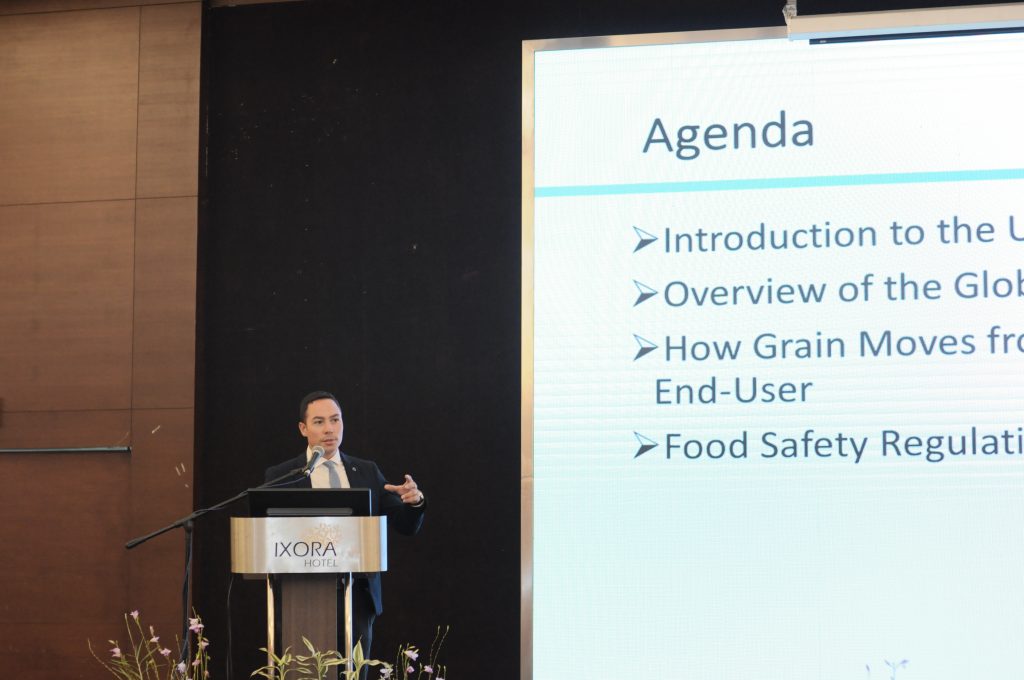Scientists, industry leaders and policymakers from across Southeast Asia recently gathered in Penang, Malaysia, for a first-of-its-kind symposium to discuss the future of corn policy, biotechnology and trade, hosted by the Malaysia Agriculture Research and Development Institute (MARDI).
Caleb Wurth, U.S. Grains Council (USGC) assistant director for Southeast Asia, spoke at the 2019 Regional Corn Conference, providing insight into why the United States is a preferred global supplier of affordable, quality inputs for the value-added meat and fish industries. His presentation included an overview of the infrastructure investment, supplier network and government policies needed to produce and distribute the U.S. corn harvest. Being asked to speak at the conference displays the high regard for the Council’s programming.
“Regional leaders acknowledge the Council’s role as experts in responsible, mutually-beneficial trade throughout the region and around the world,” Wurth said.
The conference’s location in Malaysia symbolically recognized the country’s leadership role in the formation and implementation of the socio-economic and political accord in the region, known as the Association of Southeast Asian Nations (ASEAN). The 10 countries represented by ASEAN hold strong import potential for U.S. feed grains and co-products based on an ever-growing livestock sector and relatively low local grain yields.
“Corn production and trade is a tightrope topic in which both sides have powerful stakeholders,” Wurth said. “The balance between free trade and economic support for the regional agrarian community is often at the forefront of trade policy in the region.”
Wurth’s presentation emphasized the value of free trade and the advantages of the expansive logistical network of the U.S. grain supply chain, which links farmers with end-users via a series of quality control points and safety monitoring systems. Combined with continuous monitoring systems, the United States is able to ensure the flow of products to customers around the world.
“Explanations of the quality control points of the U.S. grain trading system and the safety of modern biotechnology were well received,” Wurth said. “Furthermore, the assurance that the United States is a safe, reliable and consistent trade partner resonated with conference participants.”
The Council’s regional office in Kuala Lumpur, Malaysia, has nurtured relationships with policy makers, buyers and end-users in the region, especially as the Council has implemented fresh and innovative programming ideas.
“There are boundless opportunities for the Council to expand U.S. market share in Southeast Asia,” Wurth said. “The Council and partners will roll out new research in 2019 that is focused on quality and specific to the Southeast Asian region, which will enhance our efforts to drive up market share.”
Southeast Asia imported more than 15 million metric tons (591 million bushels) of corn in the 2017/2018 marketing year, but U.S. exports totaled 2.3 million tons (90.5 million bushels). Still, U.S. market share is increasing, due in large part to the Council’s quality-focused programming.
“The Council will continue to play an instrumental role in the growth of Southeast Asia,” Wurth said. “We will continue to sit at the table with our partners to find ways to best serve these growing markets.”
Learn more about the Council’s work in Southeast Asia here.
About The U.S. Grains Council
The U.S. Grains Council develops export markets for U.S. barley, corn, sorghum and related products including distiller’s dried grains with solubles (DDGS) and ethanol. With full-time presence in 28 locations, the Council operates programs in more than 50 countries and the European Union. The Council believes exports are vital to global economic development and to U.S. agriculture’s profitability. Detailed information about the Council and its programs is online at www.grains.org.

